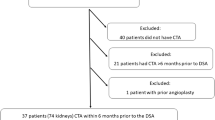Abstract
Renovascular hypertension (RVH) is a common cause of secondary hypertension. Noninvasive tests such as computed tomography angiography (CTA) or magnetic resonance angiography have a high specificity and sensitivity for the diagnosis. Digital subtraction angiography (DSA) is, however, the gold standard with which RVH can be reliably diagnosed. We report the case of a 30-year-old Chinese man with right ureter malformation and stenosis of the entire right renal artery. We discuss how to distinguish between inconsistencies in CTA results and DSA findings. Interobserver variability is an important factor that leads to such inconsistencies and cannot be ignored. Importantly, clinicians should combine imaging findings with the patient’s medical history and clinical manifestations rather than blindly believing the DSA results so as to avoid unnecessary medical disputes.
Zusammenfassung
Renovaskuläre Hypertonie (RVH) ist weiterhin die häufigste Ursache einer sekundären Hypertonie. Einige nichtinvasive Untersuchungen wie die computertomographische Angiographie (CTA) oder die Magnetresonanztomographie weisen eine hohe Spezifität und Sensitivität für die Diagnose auf. Die digitale Subtraktionsangiographie (DSA) stellt jedoch den „Goldstandard“ dar, der die zuverlässige Diagnosestellung einer RVH ermöglicht. Berichtet wird über einen 30-jährigen Chinesen mit Fehlbildung des rechten Ureters und vollständiger Stenose der rechten Nierenarterie. Wir diskutierten, wie zu differenzieren ist, wenn das CTA-Ergebnis nicht mit dem Befund der DSA übereinstimmt. Fazit: Inter-Beobachter-Variabilität war ein bedeutender Faktor, der zu nichtübereinstimmenden Befunden zwischen CTA und DSA führte, die wir nicht ignorieren konnten. Noch wichtiger aber ist es zur Vermeidung unnötiger medizinischer Diskussionen, dass klinisch tätige Ärzte die Anamnese und klinischen Symptome mitberücksichtigen sollten, statt blind dem DSA-Befund zu glauben.



Similar content being viewed by others
References
Olbricht CJ, Paul K, Prokop M et al (1995) Minimally invasive diagnosis of renal artery stenosis by spiral computed angiography. Kidney Int 48(4):1332–1337
Kaatee R, Beek FJ, Lange EE de et al (1997) Renal artery stenosis: Detection and quantification with spiral CT angiography versus optimized digital subtraction angiography. Radiology 205(1):121–127
Safian RD, Textor SC (2001) Renal artery stenosis. N Engl J Med 344(6):431–442
De Bruyne B, Manoharan G, Pijls NH et al (2006) Assessment of renal artery stenosis severity by pressure gradient measurements. J Am Coll Cardiol 48(9):1851–1855
Baumgartner I, Lerman LO (2011) Renovascular hypertension: screening and modern management. Eur Heart J 32(13):1590–1598
Spyridopoulos TN, Kaziani K, Balanika AP et al (2010) Ultrasound as a first line screening tool for the detection of renal artery stenosis: a comprehensive review. Med Ultrason 12(3):228–232
Mantha M, Kumar SK, MacGinley R et al (2010) Screening tests for diagnosis of renal artery stenosis. Nephrology (Carlton) 15(Suppl 1):218–226
Textor SC, Lerman L (2010) State of the art: renovascular hypertension and ischemic nephropathy. Am J Hypertens 23(11):1159–1169
Kim D, Porter DH, Brown R et al (1991) Renal artery imaging: a prospective comparison of intra-arterial digital subtraction angiography with conventional angiography. Angiology 42(5):345–357
Paul JF, Cherrak I, Jaulent MC et al (1999) Interobserver variability in the interpretation of renal digital subtraction angiography. AJR Am J Roentgenol 173(5):1285–1288
Conflict of interest
On behalf of all authors, the corresponding author states that there are no conflicts of interest.
Author information
Authors and Affiliations
Corresponding author
Rights and permissions
About this article
Cite this article
Liu, K., Chen, J., Peng, Y. et al. How to distinguish between inconsistencies in CTA results and DSA findings. Herz 38, 549–552 (2013). https://doi.org/10.1007/s00059-012-3723-9
Received:
Accepted:
Published:
Issue Date:
DOI: https://doi.org/10.1007/s00059-012-3723-9
Keywords
- Renovascular hypertension
- Digital subtraction angiography
- Computed tomography angiography
- Interobserver variability




